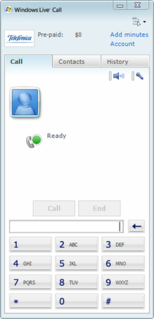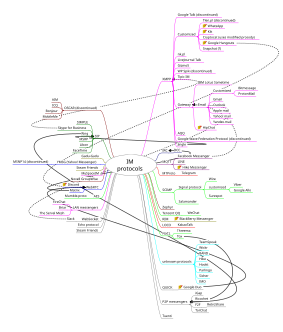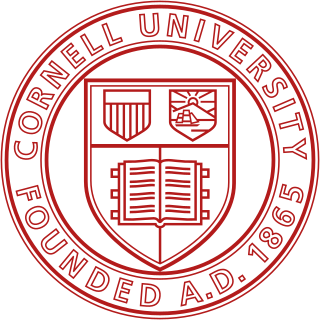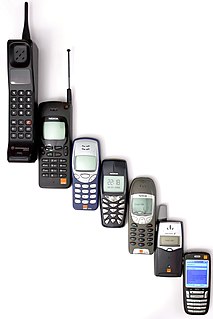A Bulletin Board System or BBS is a computer server running software that allows users to connect to the system using a terminal program. Once logged in, the user can perform functions such as uploading and downloading software and data, reading news and bulletins, and exchanging messages with other users through public message boards and sometimes via direct chatting. In the early 1980s, message networks such as FidoNet sprung up to provide services such as NetMail, which is similar to email.
The Session Initiation Protocol (SIP) is a signaling protocol used for initiating, maintaining, and terminating real-time sessions that include voice, video and messaging applications. SIP is used for signaling and controlling multimedia communication sessions in applications of Internet telephony for voice and video calls, in private IP telephone systems, in instant messaging over Internet Protocol (IP) networks as well as mobile phone calling over LTE (VoLTE).
Voice over Internet Protocol (VoIP), also called IP telephony, is a methodology and group of technologies for the delivery of voice communications and multimedia sessions over Internet Protocol (IP) networks, such as the Internet. The terms Internet telephony, broadband telephony, and broadband phone service specifically refer to the provisioning of communications services over the public Internet, rather than via the public switched telephone network (PSTN), also known as plain old telephone service (POTS).
Computer telephony integration, also called computer–telephone integration or CTI, is a common name for any technology that allows interactions on a telephone and a computer to be integrated or coordinated. The term is predominantly used to describe desktop-based interaction for helping users be more efficient, though it can also refer to server-based functionality such as automatic call routing.
A voicemail system is a computer-based system that allows users and subscribers to exchange personal voice messages; to select and deliver voice information; and to process transactions relating to individuals, organizations, products and services, using an ordinary telephone. The term is also used more broadly to denote any system of conveying a stored telecommunications voice messages, including using an answering machine. Most cell phone services offer voice-mail as a basic feature; many corporate PBXs include versatile internal voice-messaging services, and *98 vertical service code subscription is available to most individual and small business land line subscribers.

Skype is a telecommunications application that specializes in providing video chat and voice calls between computers, tablets, mobile devices, the Xbox One console, and smartwatches via the Internet. Skype also provides instant messaging services. Users may transmit text, video, audio and images. Skype allows video conference calls.

Asterisk is a software implementation of a private branch exchange (PBX). In conjunction with suitable telephony hardware interfaces and network applications, Asterisk is used to establish and control telephone calls between telecommunication endpoints, such as customary telephone sets, destinations on the public switched telephone network (PSTN), and devices or services on voice over Internet Protocol (VoIP) networks. Its name comes from the asterisk (*) symbol for a signal used in dual-tone multi-frequency (DTMF) dialing.
VoIP spam or SPIT is unsolicited, automatically dialed telephone calls, typically using voice over Internet Protocol (VoIP) technology.

A VoIP phone or IP phone uses voice over IP technologies for placing and transmitting telephone calls over an IP network, such as the Internet, instead of the traditional public switched telephone network (PSTN).
Gizmo5 was a Voice over IP communications network and a proprietary freeware soft phone for that network. On November 12, 2009, Google announced that it had acquired Gizmo5. On March 4, 2011, Google announced that the service would be discontinued as of April 3, 2011.

Videotelephony comprises the technologies for the reception and transmission of audio-video signals by users at different locations, for communication between people in real-time. A videophone is a telephone with a video display, capable of simultaneous video and audio for communication between people in real-time. Videoconferencing implies the use of this technology for a group or organizational meeting rather than for individuals, in a videoconference. Telepresence may refer either to a high-quality videotelephony system or to meetup technology, which goes beyond video into robotics. Videoconferencing has also been called "visual collaboration" and is a type of groupware.
QuteCom is a free-software SIP-compliant VoIP client developed by the QuteCom community under the GNU General Public License (GPL). It allows users to speak to other users of SIP-compliant VoIP software at no cost. It also allows users to call landlines and cell phones, send SMS and make video calls. None of these functionalities are tied to a particular provider, allowing users to choose among any SIP provider.
Forscene is an integrated internet video platform, video editing software, covering non linear editing and publishing for broadcast, web and mobile.
Mobile VoIP or simply mVoIP is an extension of mobility to a Voice over IP network. Two types of communication are generally supported: cordless/DECT/PCS protocols for short range or campus communications where all base stations are linked into the same LAN, and wider area communications using 3G/4G protocols.

Windows Live Call was part of Microsoft's Windows Live services. It integrated into Windows Live Messenger to allow users to make PC-to-PC and PC-to-Phone voice and video calls. Microsoft partnered with telecommunication companies around the world to allow users to use a PC equipped with a microphone and speakers and a high speed Internet connection to call almost any regular telephone anywhere in the world.

Google Voice is a telephone service that provides call forwarding and voicemail services, voice and text messaging, as well as U.S. and international call termination for Google Account customers in the U.S. and Canada. The service was launched by Google on March 11, 2009, after the company had acquired the service GrandCentral.
Unified communications (UC) is a business and marketing concept describing the integration of enterprise communication services such as instant messaging (chat), presence information, voice, mobility features, audio, web & video conferencing, fixed-mobile convergence (FMC), desktop sharing, data sharing, call control and speech recognition with non-real-time communication services such as unified messaging. UC is not necessarily a single product, but a set of products that provides a consistent unified user interface and user experience across multiple devices and media types.

The Iris 3000 is a SIP videophone manufactured by UMEC for ACN Inc. It features a 7-inch screen, CMOS Camera, an idle-time photo frame, and a standard phone jack to attach it to a cordless telephone for use throughout a home. It uses high-speed internet to connect with the service provider's network and thence to worldwide telephone systems.
A softphone is a software program for making telephone calls over the Internet using a general purpose computer rather than dedicated hardware. The softphone can be installed on a piece of equipment such as a desktop, mobile device, or other computer and allows the user to place and receive calls without requiring an actual telephone set. Often, a softphone is designed to behave like a traditional telephone, sometimes appearing as an image of a handset, with a display panel and buttons with which the user can interact. A softphone is usually used with a headset connected to the sound card of the PC or with a USB phone.

FriendCaller is a Video and Voice over Internet protocol developed by C2Call GmbH based in Werl, Germany. Its proprietary Voice-Over-Internet technology was originally created by Michael Knecht and Martin Feuerhahn. It was a first prototype developed by Actai Networks GmbH in 2007; the technology was then transferred to C2Call GmbH in 2008. Later on, FriendCaller was launched in 2009 as a website and as an iOS app. FriendCaller establishes peer-to-peer connectivity and allow users to communicate one-to-one or in groups via Video Chat, Voice over IP, Instant messaging, Texts/SMS, and phone calls.














